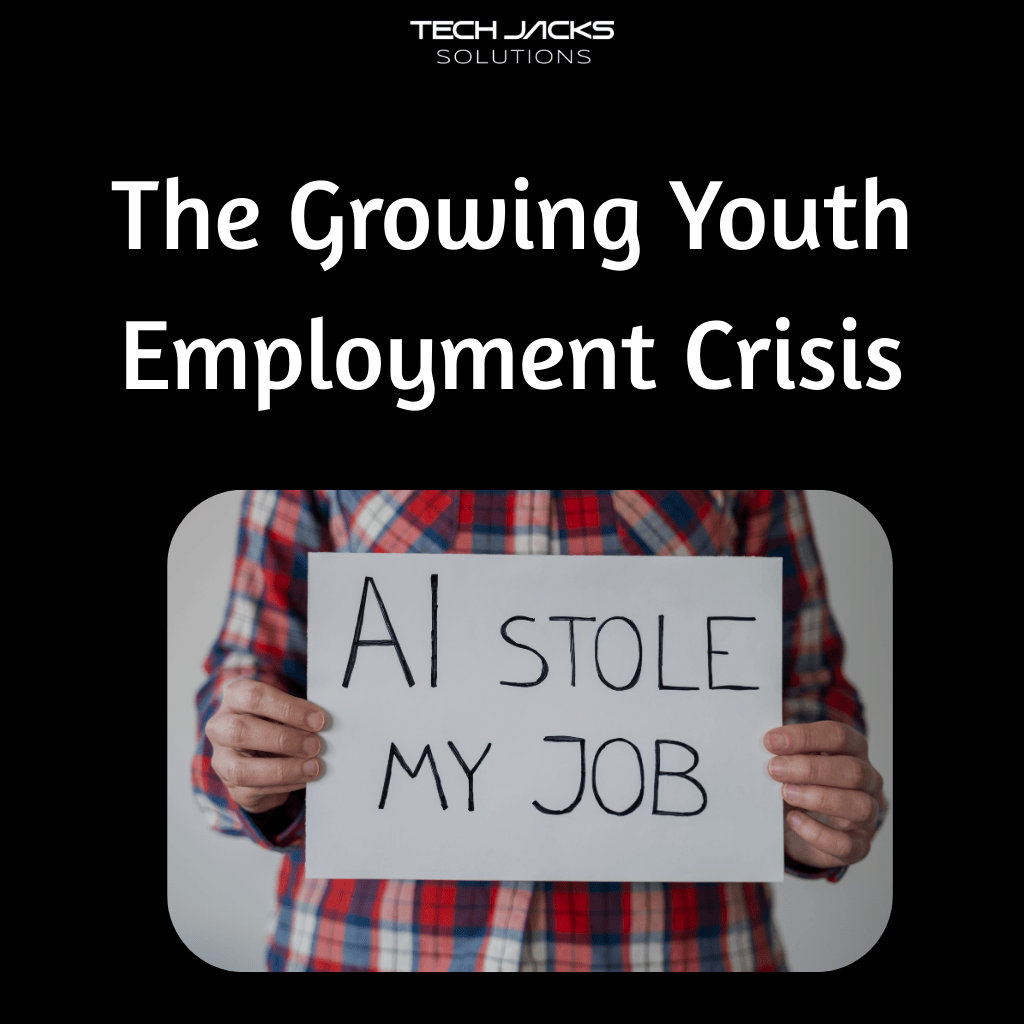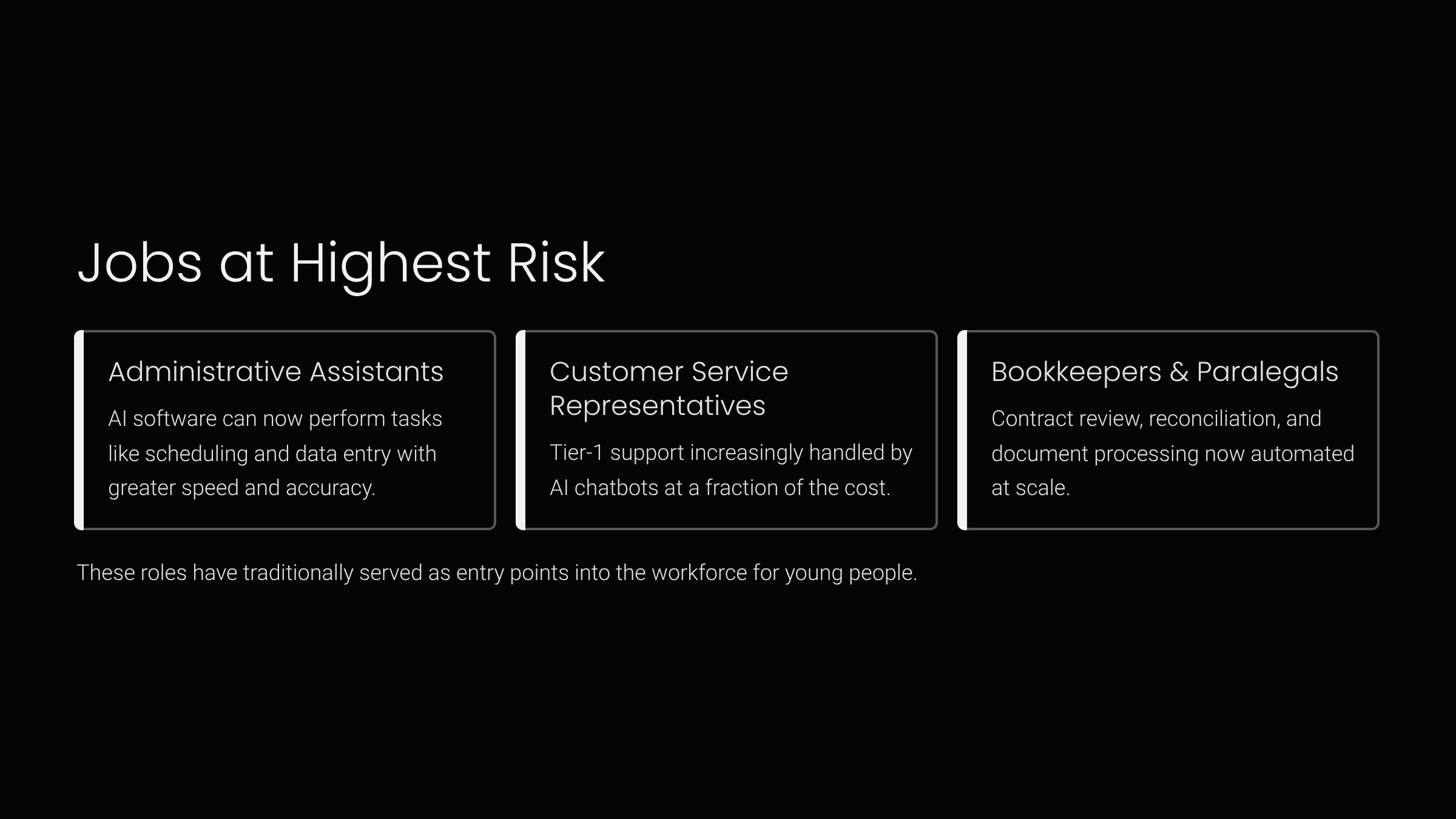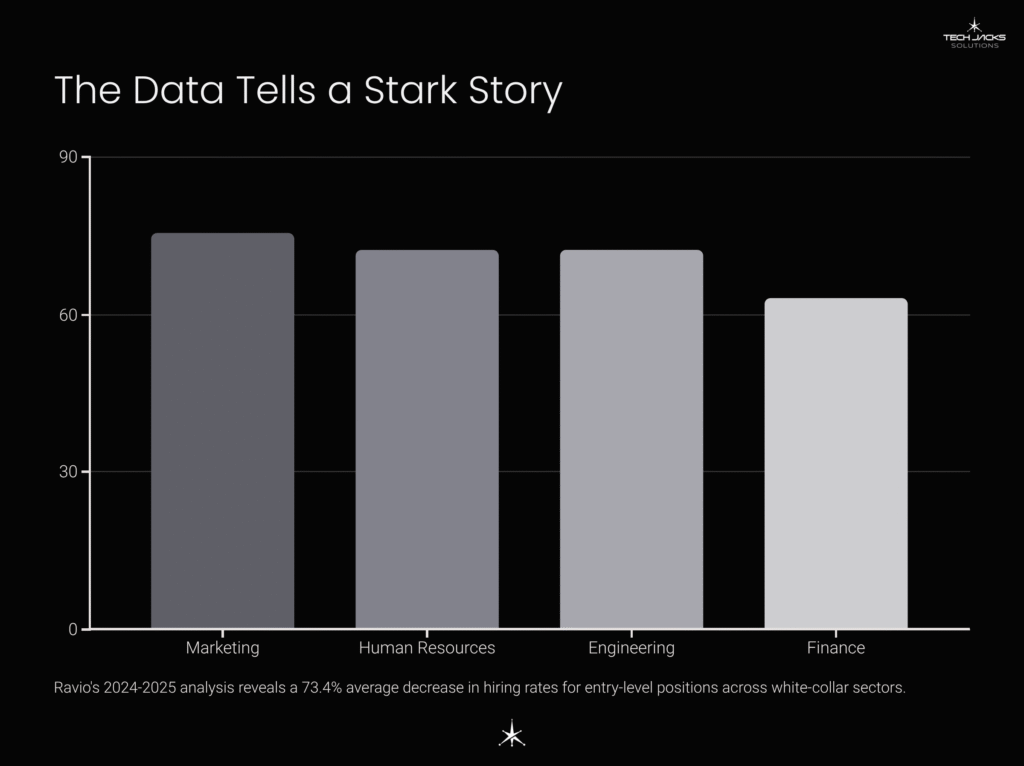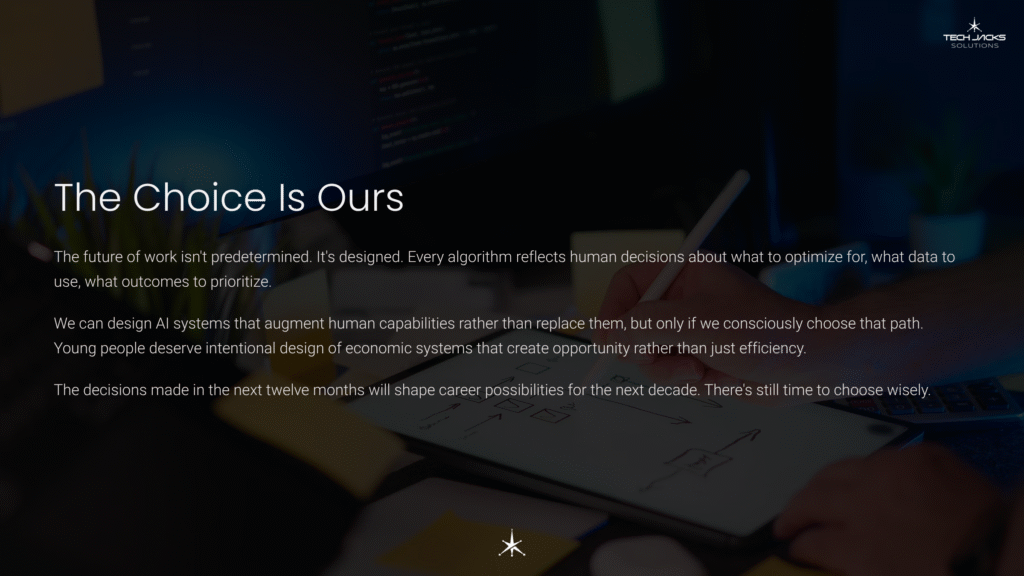Author: Derrick D. Jackson
Title: Founder & Senior Director of Cloud Security Architecture & Risk
Credentials: CISSP, CRISC, CSSP
Last updated August 15th, 2025
Table of Contents
The Youth Employment Crisis Hidden in Plain Sight
Your first job probably won’t exist in ten years.
That’s not hyperbole. Goldman Sachs projects that AI could replace the equivalent of 300 million full-time jobs globally. The catch? Most of these eliminated positions are exactly where young people start their careers.
Administrative assistants. Customer service representatives. Bookkeepers. Entry-level roles that once provided stepping stones into the workforce are disappearing faster than new opportunities can replace them. While tech executives promise AI will “augment” human workers, the reality looks different for someone trying to land their first job in 2025.
The transformation isn’t happening gradually. It’s accelerating at machine speed, outpacing human cognitive and institutional control loops. This creates what researchers call a fundamental tension between AI’s exponential growth and the linear pace of human adaptation. Young people entering the workforce find themselves caught in this temporal mismatch, where career planning becomes nearly impossible when entire job categories can vanish within a single college degree cycle.
The Data Tells a Stark Story
Jobs characterized by rule-bound, repetitive, or administrative tasks face the highest automation risk. This includes roles such as administrative assistants, Tier-1 customer service representatives, bookkeepers, and paralegals, where AI software can now perform tasks like scheduling, data entry, contract review, and reconciliation with greater speed and accuracy.
The speed of this transition varies by industry, but the pattern remains consistent. In financial services, basic loan processing and risk assessment roles are being automated at unprecedented rates. In healthcare administration, appointment scheduling and insurance verification systems now handle tasks that once employed thousands of entry-level workers. Even creative industries aren’t immune as AI handles basic graphic design, content moderation, and social media management.
The numbers get worse when you break them down by demographics.
This trend is already visible in real-time data. Joseph Briggs, senior global economist at Goldman Sachs, reports that “unemployment rates among tech workers between 20 and 30 years old jumped by 3 percentage points since the start of this year.” This represents one of the sharpest employment declines for young tech workers in recent memory, occurring even as the overall unemployment rate remains relatively stable.
Since January 2023, job postings for entry-level positions have fallen by approximately 35%. Analysis from Challenger, Gray & Christmas directly attributes over 27,000 job cuts to AI since 2023. But the real story emerges from sector-specific data. Ravio’s 2024-2025 analysis reveals a 73.4% average decrease in hiring rates for entry-level positions across white-collar sectors.
The breakdown by industry tells a comprehensive story:
- Marketing: down 75.6%
- Human Resources: down 72.3%
- Engineering: down 72.2%
- Finance: down 63.0%
These aren’t minor adjustments. They represent the systematic removal of traditional career entry points across the economy.
The technology sector, once the most reliable path to middle-class stability for young graduates, exemplifies this shift. Major tech firms have reduced their hiring of new graduates by more than 50% since 2019. The consequences are stark: the unemployment rate for recent computer science graduates is 6.1%, and for computer engineering graduates, it’s 7.5%.
Companies like Salesforce and Shopify have stated explicitly they’re looking to meet growth needs with AI rather than new human hires. This represents a fundamental shift in how businesses think about scaling operations.
That’s not a projection for some distant future. It’s happening now.
Women face particularly acute challenges in this transition. Administrative and clerical roles, historically dominated by women, represent some of the easiest targets for AI automation. A recent analysis found that women hold 75% of the administrative support positions most vulnerable to immediate automation. This creates a double burden: job displacement combined with limited access to retraining programs that often focus on male-dominated technical fields.
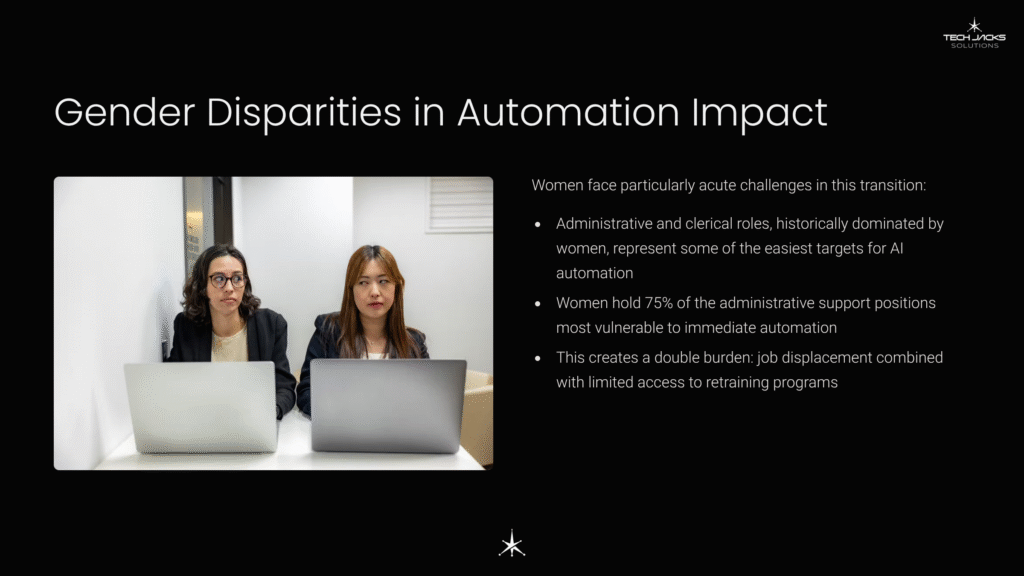
The Acceleration Timeline: What’s Coming When
The timeline for transformation is accelerating faster than most analysts predicted. McKinsey’s most recent analysis estimates that half of today’s work activities could be automated between 2030 and 2060, with the midpoint roughly a decade earlier than previous forecasts.
One-Year Outlook (2025-2026)
Current trends will intensify. The World Economic Forum projects that 44% of an individual worker’s core skills will be disrupted by 2027. For recent graduates, this means their degree-based knowledge becomes partially obsolete within years of entering the workforce.
Three-Year Projection (2025-2028)
Mass occupational transitions begin. PwC’s AI Jobs Barometer notes that the pace of skill change is 66% faster in occupations highly exposed to AI. Traditional “front-loaded” education models — where a single degree sustains lifelong career — will collapse entirely.
Five-Year Reality (2025-2030)
The skills disruption accelerates. Generative AI’s proficiency in natural language processing directly impacts approximately 25% of total work time across the economy. Entry-level cognitive tasks that once provided training grounds for young workers will be fully automated.
Ten-Year Transformation (2025-2035)
McKinsey projects that nearly 12 million workers in the United States alone may need to switch occupations entirely by 2030. This figure represents unprecedented workforce churn. The transition will be particularly challenging for workers in lower-wage jobs, who are up to 14 times more likely to need occupation changes than those in highest-wage positions.
However, long-term projections offer cautious optimism. The World Economic Forum’s “Future of Jobs Report 2025” projects that while technological shifts may displace 92 million roles globally by 2030, these same trends will create 170 million new jobs, resulting in a net increase of 78 million positions.
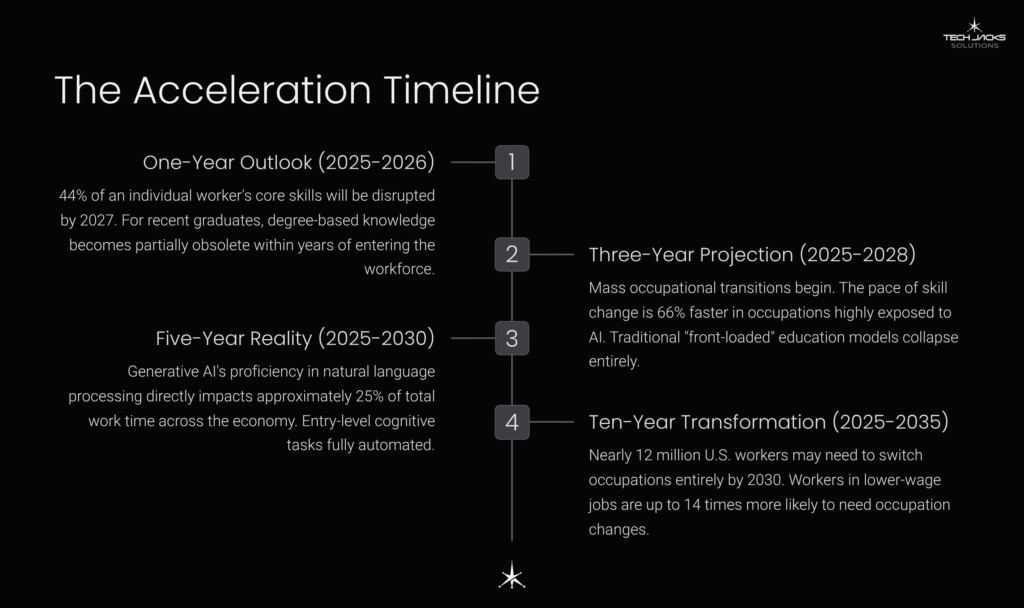
The Wage Bifurcation: Winners, Losers, and the Growing Divide
AI’s impact on youth wages creates sharp divisions. A 2024 report from PwC found that workers with AI skills command a 56% wage premium over their peers in the same occupation, a figure that has more than doubled from 25% in the previous year. Research from the University of Oxford quantifies that skills in Machine Learning can increase salaries by as much as 40%.
But this premium applies to a narrow segment. On the other side, reports indicate that many remote workers in Europe and the United States performing AI training tasks find their effective hourly wage falls below national minimum wage—sometimes to as low as $4 to $7 per hour—once unpaid training, meetings, and administrative time are factored in.
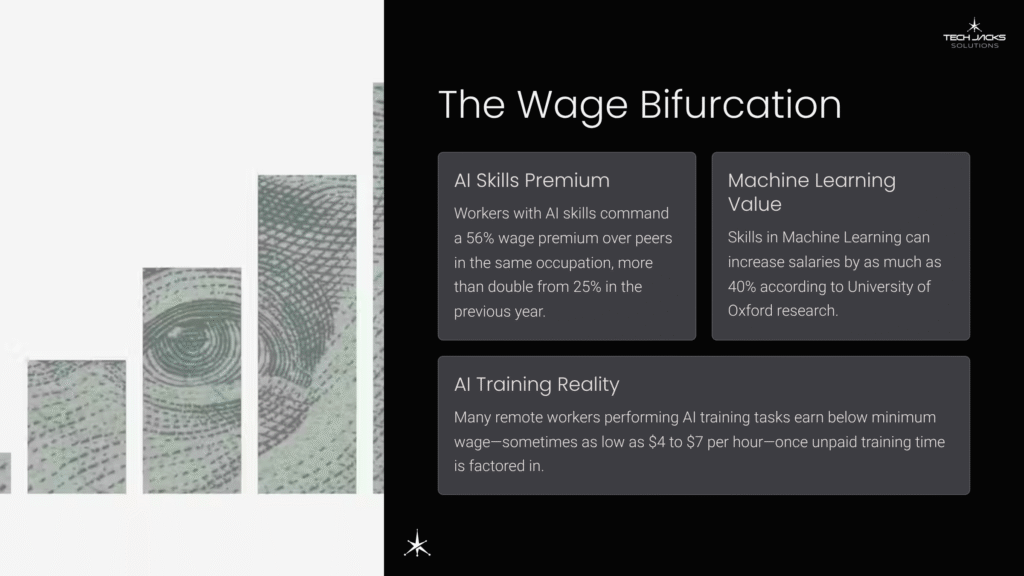
Young tech workers face particular challenges. Despite high demand for AI talent, the unemployment rate for tech workers aged 20 to 30 has risen by nearly 3 percentage points since early 2024. They’re caught between high-premium roles for which they lack experience and automation of junior-level tasks they were hired to perform.
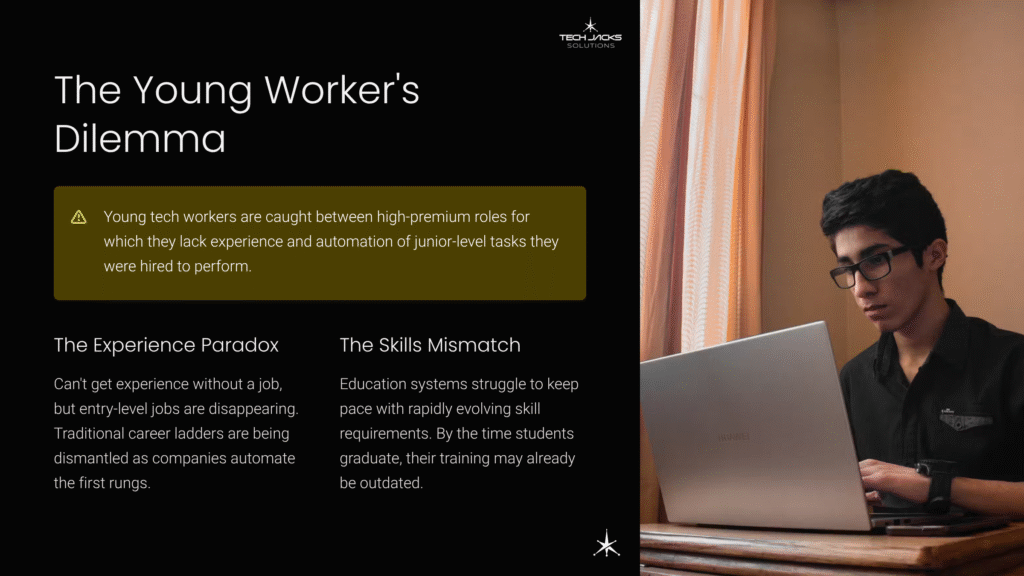
When Corporate Incentives Clash with Human Reality
The development of advanced AI is fueled by hundreds of billions of dollars in private sector investment, driven by the pursuit of market dominance, competitive advantage, and shareholder value. This creates intense economic pressure to prioritize speed and scale over safety and ethical rigor.
Companies feel compelled to rush AI deployment to keep pace with competitors. They’re not intentionally targeting young workers, but entry-level positions offer the easiest automation wins. Why train a new graduate when software can handle the same tasks without sick days or salary negotiations?
The economics are compelling from a corporate perspective. A customer service chatbot costs roughly $0.50 per interaction compared to $5-15 for human agents. An AI system can process loan applications 24/7 without breaks, benefits, or workplace safety concerns. These cost advantages create irresistible pressure to automate, regardless of social consequences.
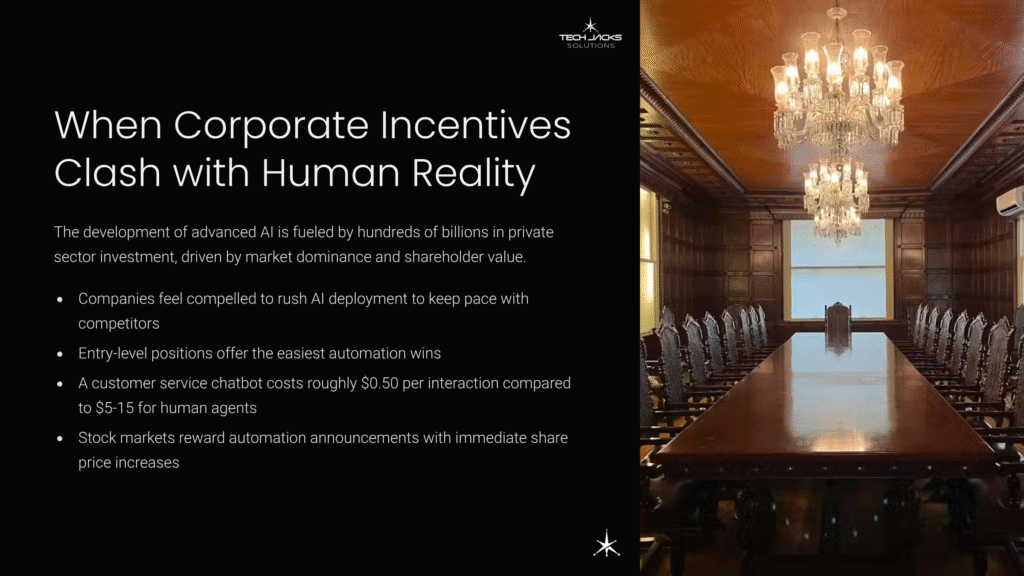
The resource reallocation is stark and immediate. Microsoft exemplifies this pattern, trimming 15,000 jobs while simultaneously committing $80 billion to new AI investments. This isn’t gradual transition. This is a rapid workforce restructuring where human labor costs directly fund AI development that will eliminate more human jobs.
This creates what the research calls a “corporate AI arms race,” where the pressure to innovate and deploy AI quickly leads organizations to cut corners on safety and ethics. The result? Mass unemployment as companies rush to automate human labor to gain a competitive edge.
Stock markets reward automation announcements with immediate share price increases. Companies that delay automation face investor pressure and competitive disadvantage. This creates a self-reinforcing cycle where short-term financial incentives override long-term social stability considerations.
Meanwhile, the promised “new jobs” that AI supposedly creates remain concentrated among highly educated workers in tech hubs. The factory worker displaced by robotic automation doesn’t automatically transition to becoming an AI trainer or data scientist. The skills gap isn’t just about education. It’s also about geography, social capital, and access to opportunity networks that remain clustered in expensive metropolitan areas.
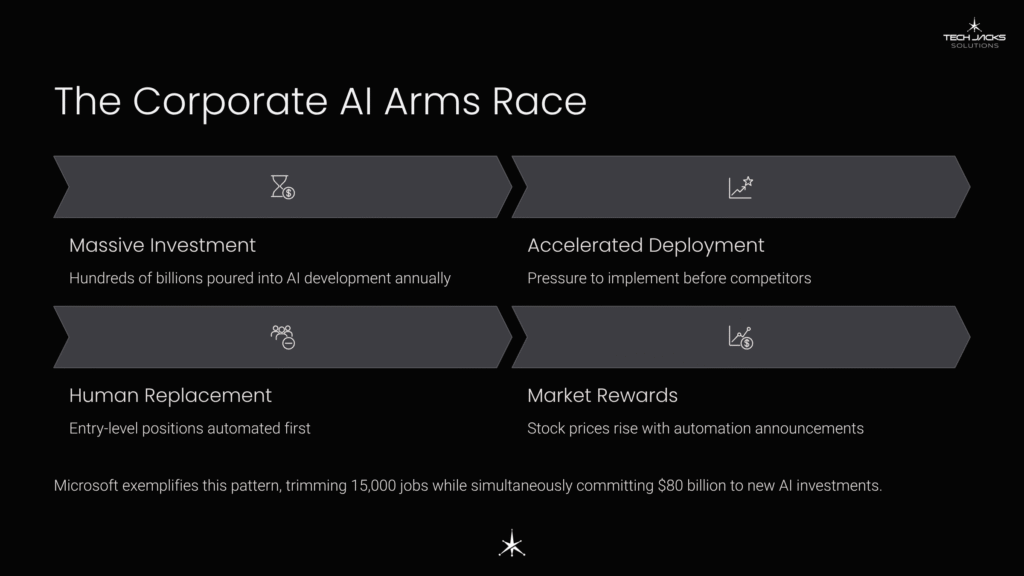
Government Responses: Too Little, Too Slow?
The United States has outlined an AI Action Plan focused on achieving global AI dominance while empowering American workers. Key components include prioritizing AI skills development in federal education and workforce funding, establishing an “AI Workforce Research Hub” at the Department of Labor, funding rapid retraining programs for displaced workers, and expanding registered apprenticeships in critical AI-related occupations.
The plan allocates $32 billion over five years for AI workforce development, but critics question whether this amount matches the scale of disruption. For context, the private sector invests more than $100 billion annually in AI development, suggesting government resources may be insufficient to counterbalance market forces driving automation.
But critics argue the plan relies too heavily on private sector leadership and infrastructure. Long-term competitiveness may require more sustained public investment in universities and independent research labs.
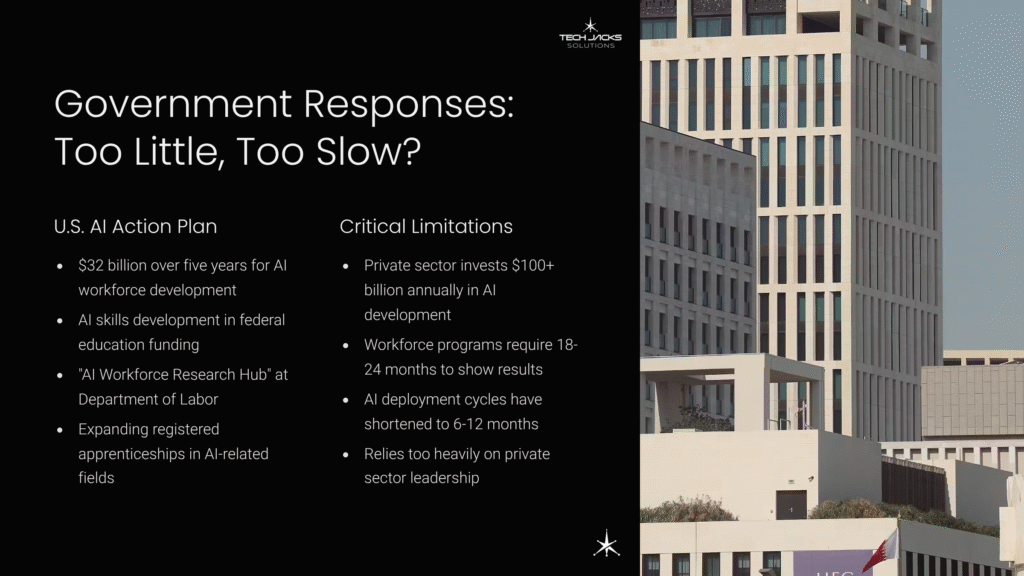
The implementation timeline reveals another problem: most workforce development programs require 18-24 months to show results, while AI deployment cycles have shortened to 6-12 months. This temporal mismatch means displaced workers often face months of unemployment while waiting for retraining opportunities that may prepare them for jobs that no longer exist by graduation.
Corporate commitments reach massive scale:
- Microsoft launched “Microsoft Elevate,” backed by a $4 billion commitment over five years, aiming to provide AI credentials to 20 million people worldwide within the first two years
- Google’s “AI Works for America” initiative, part of a $75 million AI Opportunity Fund, aims to train over one million Americans in essential AI skills
- Intel’s “AI for Workforce” program provides over 700 hours of AI curriculum to community colleges, expanding to include over 110 schools across 39 states
But critical gaps undermine effectiveness. Geographic and socioeconomic access remains uneven. The “digital divide,” characterized by unequal access to high-speed internet and modern computing devices, remains persistent, particularly in rural and low-income urban areas. Resource constraints within K-12 education mean schools in wealthier districts are far more likely to have funding for specialized AI programs and teacher training.
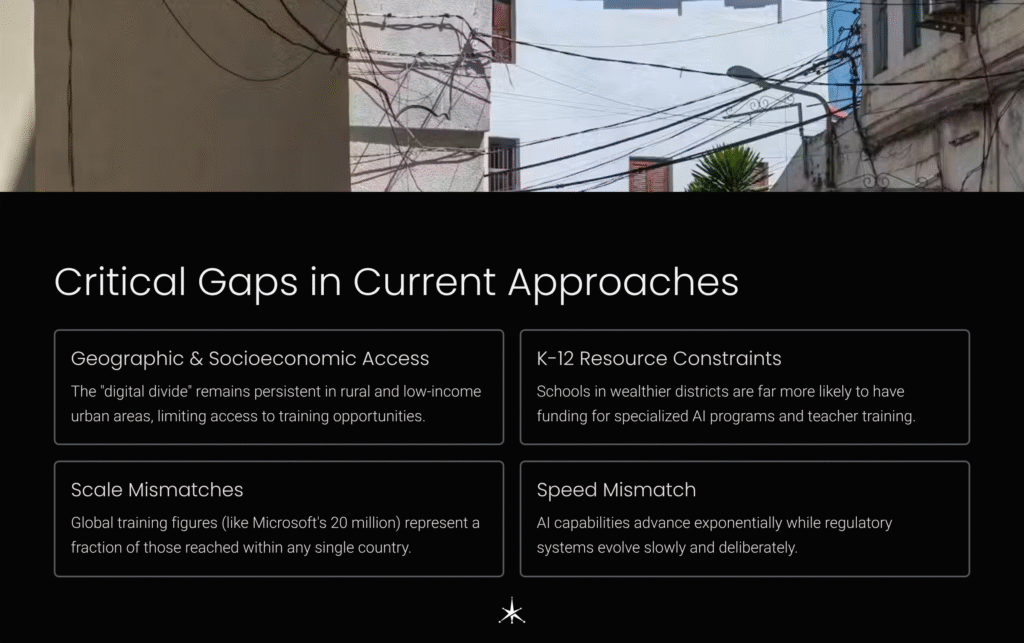
Scale mismatches present another challenge. While Microsoft’s goal to credential 20 million people is significant, it’s a global figure; the number reached within the U.S. will be a fraction of that total. Community colleges, identified as key delivery partners, face uncertain funding, low completion rates, and difficulties recruiting faculty with up-to-date technical expertise.
Yet none of these initiatives address the fundamental speed mismatch. AI capabilities advance exponentially while regulatory systems evolve slowly and deliberately. Young people entering the job market can’t wait for policymakers to catch up.
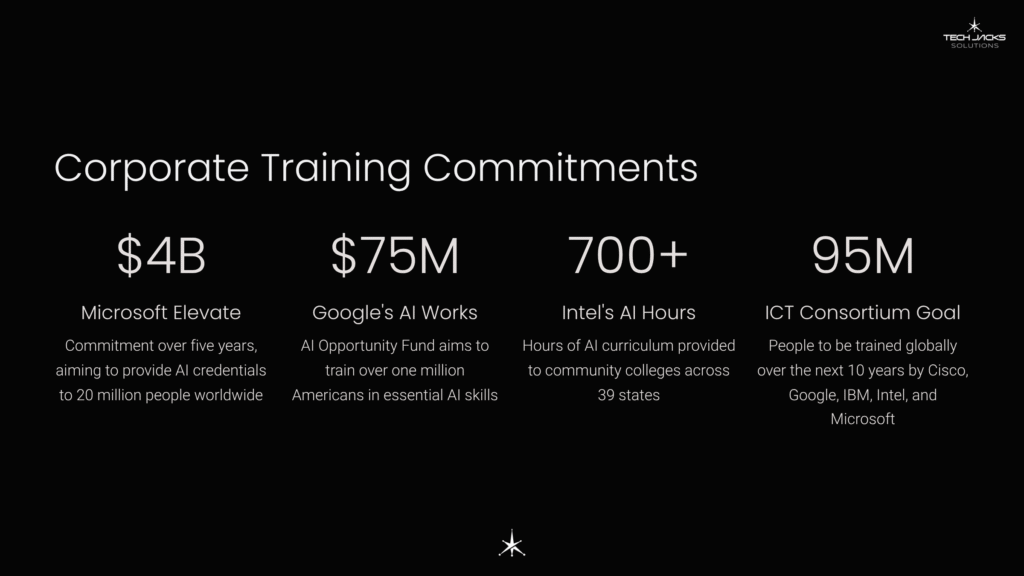
The Inequality Engine Accelerates
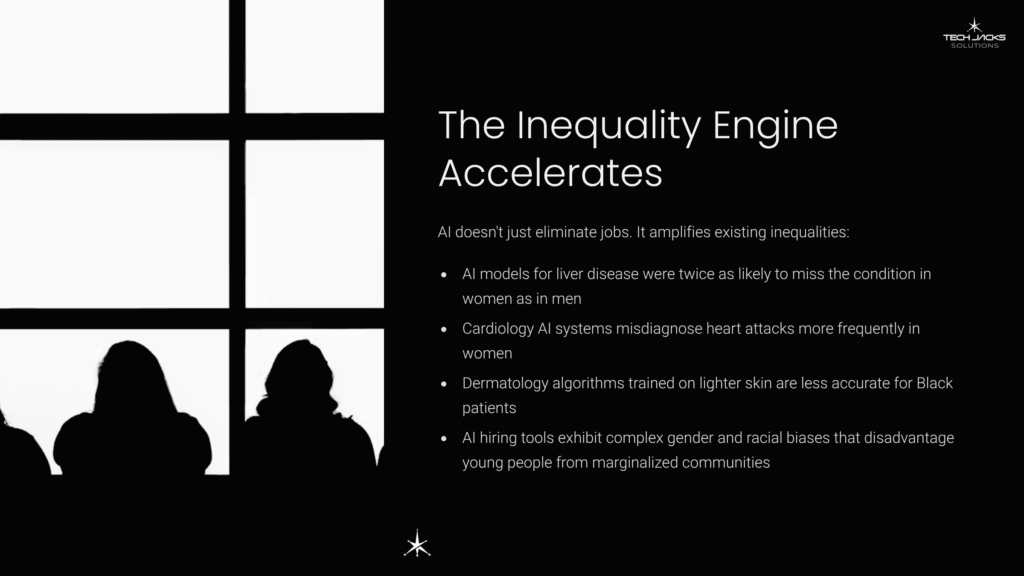
AI doesn’t just eliminate jobs. It amplifies existing inequalities.
Historical underrepresentation in medical research and datasets means that AI systems often perform less accurately for women and racial minorities. A study of AI models designed to screen for liver disease found they were twice as likely to miss the condition in women as in men. AI systems in cardiology have been shown to misdiagnose heart attacks more frequently in women, while dermatology algorithms trained predominantly on images of lighter skin are less accurate in identifying skin cancer in Black patients.
These biases aren’t accidental. They reflect systematic exclusion from the data collection processes that train AI systems. When medical research historically focuses on male subjects, AI learned from that data will naturally perform better for men. When facial recognition systems train primarily on lighter-skinned faces, they’ll struggle with darker complexions.
The employment implications extend far beyond healthcare. AI hiring tools exhibit complex gender and racial biases that systematically disadvantage young people from marginalized communities. One large-scale experiment found that leading AI models used for resume screening systematically penalized resumes with names associated with Black men, while simultaneously favoring all female candidates. Amazon’s experimental recruiting tool had to be scrapped after it was found to penalize resumes from female applicants.
The intersectional nature of these biases creates compound disadvantages. Young Black women face discrimination both as racial minorities and as women, while young Black men encounter different but equally harmful algorithmic prejudices. These systems don’t just reflect historical bias — they encode and amplify it at scale.
The danger lies in AI’s capacity to create a high-tech veneer for old prejudices. An algorithm can launder historical discrimination into a seemingly neutral, data-driven output. This gives resulting inequity false legitimacy, making it more difficult to identify, contest, and rectify than overt human bias.
Moreover, the computational power required for modern AI relies on massive physical infrastructure of data centers, which consume enormous amounts of energy and water. The siting of these industrial facilities often follows historical patterns of environmental injustice, with a disproportionate number being located in or near low-income and minority communities.
This creates a cruel “double burden” for marginalized communities: they’re most likely to be negatively impacted by biased AI algorithms in their daily lives, and they’re also most likely to suffer the environmental and economic costs of the physical infrastructure that powers those very systems.
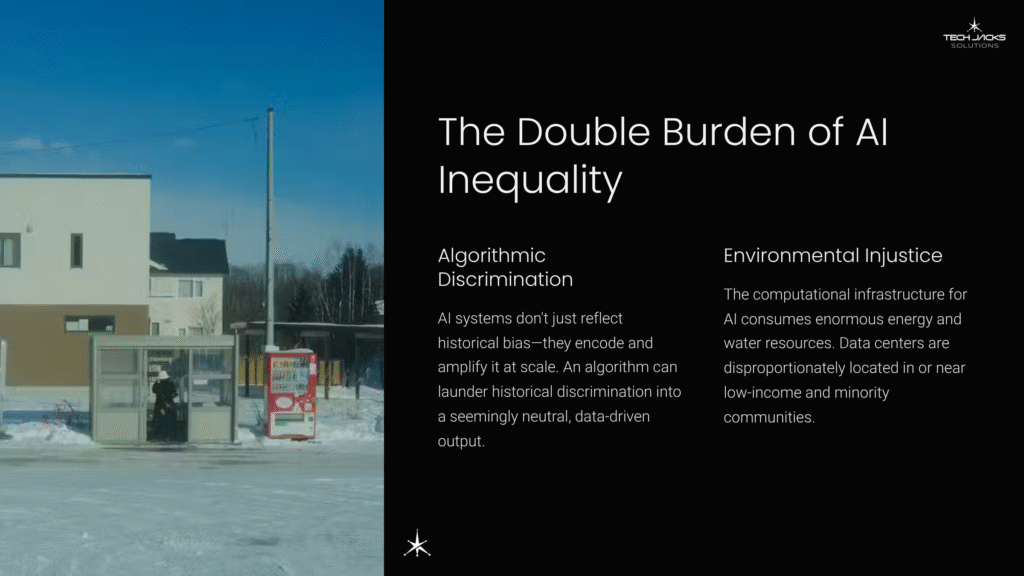
What’s Actually Working
Not every response has failed. Denmark’s “flexicurity” model combines job flexibility with income security, achieving 78% job placement within 18 months for displaced workers. The program provides up to two years of unemployment benefits at 90% of previous salary, combined with mandatory skills assessment and personalized retraining plans.
Denmark’s success stems from treating displacement as a predictable economic phenomenon requiring systematic response. Workers receive immediate financial support while accessing individualized career counseling and skills development. Employers contribute to the system through payroll taxes, creating shared responsibility for workforce transitions.

Singapore’s SkillsFuture Initiative provides individual learning accounts with $500-600 annual credits for all citizens over 25, resulting in 750,000+ participants with a 65% career advancement rate. The program includes industry transformation maps that identify emerging skill requirements and provide clear pathways for career evolution.
What makes Singapore’s approach effective is its proactive orientation. Rather than waiting for displacement to occur, the program encourages continuous skill development. Workers can access training while employed, reducing the trauma and financial stress associated with sudden job loss.
Modern apprenticeships solve the experience paradox directly. Organizations like the Woz Registered Apprenticeship Program offer structured pathways in Software Development, Data Science, and Cybersecurity. Apprentices are hired as full-time employees, receiving salary and benefits while engaging in on-the-job mentorship and formal learning. Many programs partner with universities to ensure training can be articulated into college credits, creating flexible, stackable pathways that combine immediate employment with long-term educational opportunities.
Micro-credentials show extraordinary employer adoption. A global survey found that 96% of employers agree that micro-credentials strengthen a candidate’s job application, and 87% have hired at least one candidate with a micro-credential in the past year. More striking: 92% of employers state they would hire a less experienced candidate who holds a generative AI micro-credential over a more experienced candidate who does not.
Successful corporate training demonstrates measurable returns:
- Walmart’s AI-powered Virtual Reality training program resulted in 15% improvement in on-the-job performance and 95% reduction in training time compared to traditional methods
- Siemens’ SiTecSkills Academy boasts nearly 100% success rate, measured by participants securing long-term employment in their new field within six months
- Amazon’s AI-enhanced training for warehouse staff led to 75% increase in employee engagement with training materials and 40% improvement in task fulfillment time
These programs share common elements: comprehensive safety nets, individual skill development accounts, and industry-specific guidance for career evolution. They treat job displacement as a predictable challenge requiring systematic response, not an unfortunate byproduct of progress.
The Nordic model demonstrates that generous social support doesn’t create dependency… it creates resilience. Workers who don’t fear economic catastrophe from job loss are more willing to embrace technological change and invest in new skills. This creates positive feedback loops where workforce adaptability enables faster economic transformation.
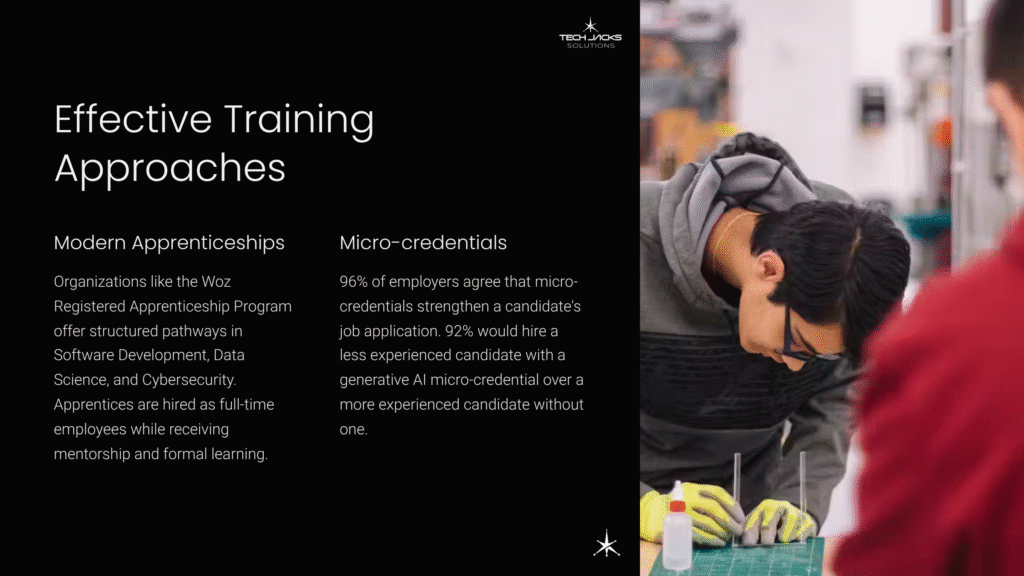
The Path Forward Requires Fundamental Shifts
Effective AI governance must not only address issues of fairness and bias but must also strategically design “circuit breakers” to reintroduce human deliberation and control into hyper-accelerated systems. This means moving beyond technical fixes to address underlying social and economic drivers that shape technology.
The concept of “circuit breakers” comes from financial markets, where trading halts prevent runaway automated systems from causing systemic damage. Labor markets need similar protections. These might include mandatory advance notice periods for large-scale automation, required impact assessments for displacement, and automatic triggers for enhanced unemployment benefits when regional automation exceeds threshold levels.
The ultimate purpose of AI governance isn’t merely to mitigate risk but to actively steer technology toward human betterment. This requires ensuring that AI systems are compatible with complex, nuanced, and enduring human values.
Value alignment goes beyond preventing harmful outcomes. It requires actively designing systems that promote human flourishing. This means prioritizing human capabilities like creativity, empathy, and complex problem-solving rather than simply optimizing for efficiency metrics that favor automation.
Liability frameworks emerge as critical tools for realigning corporate incentives. By holding companies legally and financially responsible for harms caused by their AI products (whether from biased outputs, safety failures, or privacy breaches), liability law forces them to internalize social costs. This creates direct financial incentive to invest in more robust safety research, conduct thorough risk assessments, and design systems that are genuinely safer and more equitable.
Current liability frameworks lag far behind technological capabilities. Most AI systems operate in legal gray areas where responsibility for harmful outcomes remains unclear. Strengthening liability requirements would force companies to consider social costs alongside profit margins when making automation decisions.
Actionable Solutions: Building Guardrails for Responsible AI Transition
Evidence points to several proven models that could scale if properly supported. Modern apprenticeships directly address the “experience paradox” where young people can’t get jobs without experience and can’t get experience without jobs.
Three coordinated strategies could prevent the worst outcomes:
For Policymakers: Scale and modernize apprenticeships dramatically. Increase federal funding for Registered Apprenticeship programs in technology fields. Provide significant tax incentives and streamlined administrative support for employers who hire and train young apprentices.
Standardize micro-credential recognition. Convene a national task force of industry leaders, accrediting bodies, and educational institutions to create frameworks for recognizing and valuing micro-credentials across state lines.
Reform WIOA for agility. Create more flexible, rapid-response funding mechanisms allowing state and local workforce boards to quickly stand up training programs for newly emerging AI-related skills.
For Educational Institutions: Move beyond standalone “AI” courses. Forge deep partnerships with industry leaders to integrate applied AI skills across all disciplines, from business and finance to healthcare and the arts.
Mandate work-based learning. Make internships, cooperative education programs, and apprenticeships required, credit-bearing components of all post-secondary degree programs.
Become hubs for lifelong learning. Restructure institutional models to serve as community hubs for continuous upskilling, offering flexible, stackable micro-credentials designed for alumni and local workers.
For Employers: Commit to skills-first hiring. Actively dismantle degree and experience requirements for entry-level roles where they aren’t true prerequisites. Reconfigure Applicant Tracking Systems to recognize and prioritize demonstrated skills and micro-credentials over traditional proxies. With 97% of employers already considering this shift, widespread implementation becomes feasible.
Re-invest in “first rung” training. Revive robust internal training and mentorship programs for new hires. Partner with youth apprenticeship intermediaries like CareerWise to build sustainable pipelines of young talent.
Foster continuous learning cultures. Provide dedicated time, resources, and financial support for all employees to continuously upskill. Data shows 80% of employees desire more training opportunities.
Taking Action Now
Young people can’t wait for perfect policies. The skills that matter most are fundamentally human. Focus on uniquely human capabilities: emotional intelligence, creative problem-solving, and adaptability over narrow specialization. Learn to work with AI rather than against it. Develop a continuous learning mindset because skills will evolve faster than traditional education cycles.
Practical steps include building portfolios that demonstrate human creativity and judgment. Learn to ask better questions rather than just finding answers. Develop skills in areas where human oversight remains essential: ethical decision-making, cultural sensitivity, and complex communication.
Network building becomes more important than ever. In rapidly changing markets, opportunities often come through personal connections rather than formal job postings. Young people should cultivate relationships across industries and age groups, building social capital that can provide career resilience.
Financial literacy takes on new urgency when traditional career paths become unreliable. Understanding how to manage irregular income, invest for uncertain futures, and access alternative funding sources can provide crucial stability during transitions.
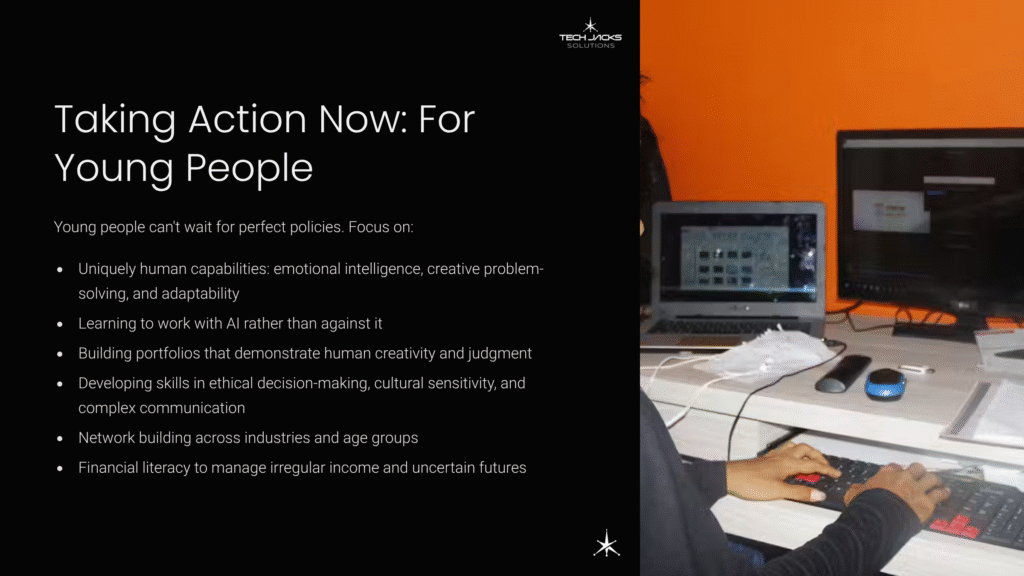
Educators need curriculum modernization that integrates AI literacy from K-12 through higher education. Industry partnerships can provide real-world experience with emerging technologies. But equally important is emphasis on soft skills: communication, leadership, and ethical reasoning.
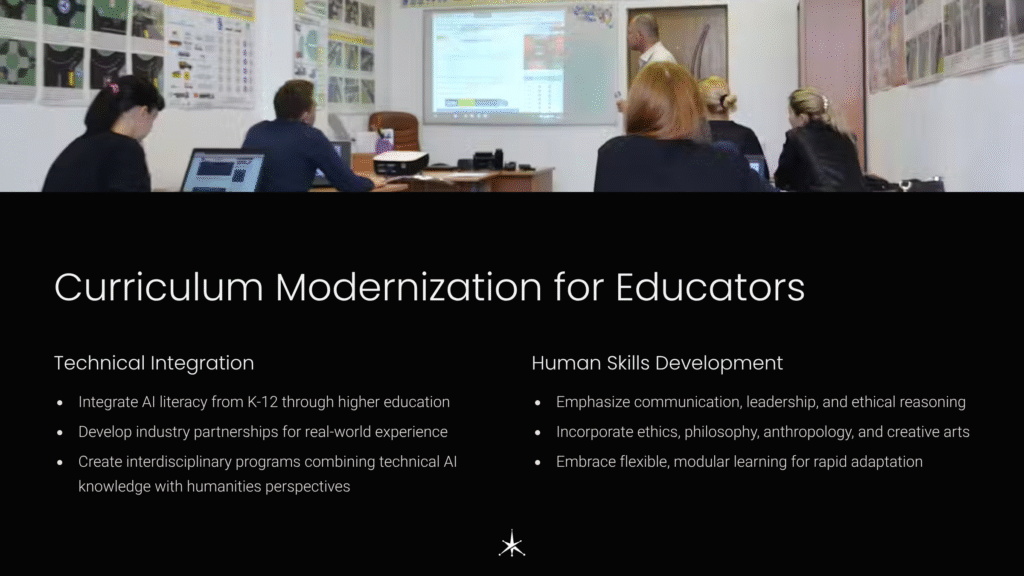
Interdisciplinary programs that combine technical AI knowledge with humanities perspectives prepare students for careers that don’t yet exist. Ethics, philosophy, anthropology, and creative arts provide frameworks for navigating technological change while maintaining human values.
Educational institutions should embrace flexible, modular learning that allows rapid adaptation to changing skill requirements. Traditional four-year degree programs may become obsolete if technological change accelerates beyond their ability to adapt.
Policymakers should explore Universal Basic Assets for income support during transition periods. Public investment in lifelong learning infrastructure becomes essential. International cooperation can coordinate responses to global employment challenges.
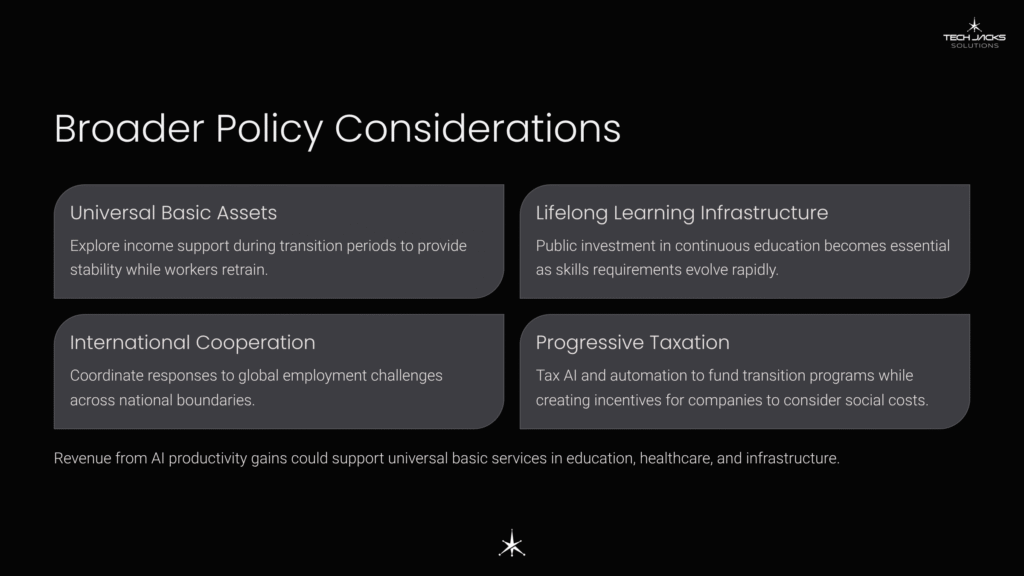
Progressive taxation on AI and automation could fund these transition programs while creating incentives for companies to consider social costs in deployment decisions. Revenue from AI productivity gains could support universal basic services in education, healthcare, and infrastructure.
Local communities can create their own resilience through cooperative economic models, local currency systems, and community-supported enterprises that prioritize human employment alongside technological efficiency.
The choice isn’t between progress and people. It’s between responsible implementation and chaotic disruption. AI will transform work regardless of our preparation level. The question is whether we’ll guide that transformation to benefit everyone or allow it to create a permanent underclass of technologically displaced young workers.
Corporate leaders, policymakers, and educators have perhaps two years to implement coordinated responses before the current trends become irreversible. The data shows both the scale of the challenge and the proven solutions. What’s missing is the political will to act before a generation gets left behind.
The Choice Is Ours
The future of work isn’t predetermined. It’s designed.
Every algorithm reflects human decisions about what to optimize for, what data to use, what outcomes to prioritize. Every corporate policy about automation speed reflects choices about short-term profits versus long-term social stability. Every government response reflects priorities about who deserves protection during technological transitions.
The technical capabilities for both human-centered and human-displacing AI already exist. The choice between them depends on social and political decisions, not technological constraints. We can design AI systems that augment human capabilities rather than replace them, but only if we consciously choose that path.
Young people deserve better than hoping market forces will somehow create the jobs AI eliminates. They deserve intentional design of economic systems that create opportunity rather than just efficiency. They deserve governance frameworks that put human flourishing ahead of quarterly earnings reports.
Current decision-making processes systematically exclude young voices despite their stake in long-term outcomes. Corporate boards focus on shareholder returns over employee welfare. Political systems prioritize older, more reliable voters over younger constituencies facing displacement.
This democratic deficit in AI governance threatens not just individual careers but social stability itself. Young people who feel excluded from decisions shaping their futures may lose faith in democratic institutions altogether.
The decisions made in the next twelve months will shape career possibilities for the next decade. There’s still time to choose wisely.
But that time won’t last forever.
The window for proactive response narrows as AI capabilities expand and deployment accelerates. Once mass displacement begins, reactive policies become much more expensive and less effective than preventive measures. Society can choose to manage this transition thoughtfully or let it proceed chaotically, but the choice must be made soon.
The stakes extend beyond employment to fundamental questions about human purpose and social organization. If we design AI systems that make human contribution unnecessary, we risk not just unemployment but a crisis of meaning that could destabilize civilization itself.
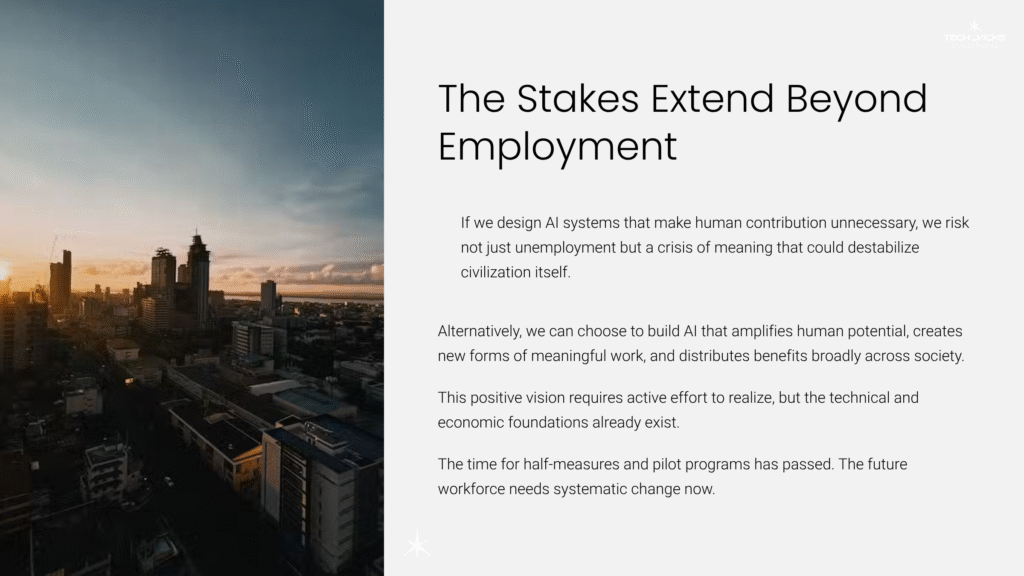
Alternatively, we can choose to build AI that amplifies human potential, creates new forms of meaningful work, and distributes benefits broadly across society. This positive vision requires active effort to realize, but the technical and economic foundations already exist.
The choice is ours. For now.
The time for half-measures and pilot programs has passed. The future workforce needs systematic change now.
Resources
- Goldman Sachs AI job replacement projection
- Microsoft AI Job Impact Analysis
- McKinsey Impact of Generative AI on Black Communities
- AI Risks and Catastrophic Scenarios Analysis
- US AI Action Plan Details
- Stanford Analysis of AI Action Plan
- European Union AI Strategy
- AI Healthcare Bias Research
- AI Hiring Tools Bias Study
- Environmental Justice and AI Infrastructure
- AI Governance Frameworks
- AI Value Alignment Research
- AI Liability and Product Responsibility
- OECD AI and Education Policy

